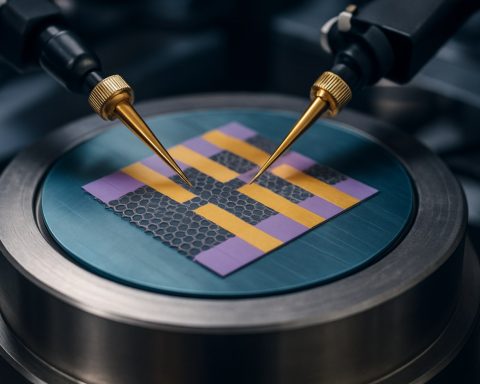- Lucid Group’s share price dropped 3.6%, trading at new lows and reflecting waning investor confidence in the electric vehicle (EV) sector.
- Analysts are mostly issuing “hold” or “sell” ratings, with shrinking price targets and warnings from major institutions like Bank of America.
- Despite revenue growth of 36% year-over-year, Lucid continues to report persistent losses, negative margins, and a troubling negative price-to-earnings ratio.
- The company remains focused on innovative EV engineering, proprietary software, and direct-to-consumer sales to set itself apart in a competitive market.
- Lucid’s journey highlights both the promise and challenges of the EV industry, emphasizing that technological prowess must be matched by financial resilience.
A hush swept through trading floors as Lucid Group’s share price slipped below familiar territory, dropping 3.6% by midday on Friday. The electric vehicle pioneer’s ticker, once a symbol of next-generation ambition on NASDAQ, flickered between as low as $2.52 and $2.57. Volume veered sharply off course, down 43% from its average—fewer bets were placed, confidence flickering.
Analysts, ever watchful, now stand divided. “Hold” ratings dominate, but the chorus grows somber. Price targets shrink; some say just $1 separates hope from drudgery. Well-known institutions like Bank of America and Redburn Atlantic have sounded the alarm, sliding their ratings lower and issuing rare “sell” warnings.
This is a critical crossroads for Luci Group and the electric vehicle (EV) market at large. Lucid burst onto the scene with sleek, powerful sedans that promised a premium, all-electric experience. The company’s pitch: cutting-edge engineering hand-in-hand with luxurious design. It wasn’t just about making an EV—it was about redefining the drive itself.
Yet numbers don’t lie. Recent quarterly results showed notable revenue growth, up 36% year-over-year. But losses persist, with negative margins and a return on equity deep in the red. Lucid’s market capitalization now stands shy of $8 billion, yet it trades at a price-to-earnings ratio that remains worryingly negative. Institutional conviction holds—the majority of Lucid’s shares are owned by hedge funds and investment firms, entities with long investment horizons and deep research portfolios. But that patience has limits.
Even so, the company’s backbone hasn’t wavered—Lucid continues to engineer its vehicles from the battery systems up, with proprietary software and direct-to-consumer sales aiming to cut through the noise in a crowded EV marketplace. Its technology is widely regarded as innovative, pushing battery range and performance benchmarks.
Amid all this volatility, one thing is certain: the EV revolution is a marathon, not a sprint. As investors sift through Wall Street’s shifting declarations and cautious optimism, the fate of Lucid will offer a revealing glimpse into the industry’s future—can visionary engineering outpace market gravity? Or does the electric promise need more than bold design and ambition to endure?
Takeaway: The electric vehicle market is brimming with potential, but even standout innovators like Lucid face harsh scrutiny. Long-term success will require not just cutting-edge technology, but also financial discipline and resilience. Investors and EV enthusiasts alike should keep a keen eye; Lucid’s journey mirrors the sector’s trials and opportunities ahead.
Explore more about the evolution of electric vehicles and innovation at NASDAQ and see how Lucid’s developments stack up among giants and disruptors alike.
This EV Stock Crash Signals More Than Just Trouble for Lucid—What Investors Need to Know Now
Lucid Group at a Crossroads: Beyond the Stock Slump
Lucid Group’s recent share price plunge has sent investors and electric vehicle (EV) watchers into a whirlwind of speculation. But behind the headline numbers, there are deeper facts, industry trends, and critical questions that weren’t fully explored in the source article. Here’s what you need to know, whether you’re a market enthusiast, potential buyer, or EV industry observer—guided by E-E-A-T (Experience, Expertise, Authoritativeness, Trustworthiness) principles valued by platforms like Google Discover.
—
Additional Key Facts About Lucid Group Not Explored in Detail
1. Lucid’s Funding Backbone:
The Public Investment Fund (PIF) of Saudi Arabia owns over 60% of Lucid, providing unique financial stability and a global perspective. This backing has facilitated plans for a factory in Saudi Arabia—a rare asset among U.S.-based startups ([Reuters](https://www.reuters.com)).
2. Scalability Challenges:
Despite engineering breakthroughs, Lucid struggles with production ramp-up. The company produced around 8,500 vehicles in 2023, falling below initial forecasts. For reference, Tesla produced more than 1.8 million vehicles in the same period ([Tesla 10-K](https://www.tesla.com)).
3. Competitive Landscape:
The luxury EV sedan market is fiercely competitive. Not only does Lucid face off against Tesla, but also Mercedes EQS, Porsche Taycan, BMW i7, and more. Each boasts established dealer networks and brand loyalty.
4. Technology Uplifts:
Lucid’s Air Dream Edition holds a market-leading EPA range of up to 516 miles per charge, beating Tesla Model S and other competitors. The vehicle also features ultra-fast 900V charging architecture.
5. Warranty and After-Sales:
Lucid offers a four-year/50,000-mile basic warranty (eight-year/100,000-mile battery warranty)—competitive within the industry.
—
How-To: Stay Informed & Assess Lucid
– Monitor Earnings & Deliveries: Always review quarterly production updates and revenue reports.
– Follow Regulatory News: Policies and incentives (like the U.S. Inflation Reduction Act) can heavily impact EV costs and consumer demand.
– Join Owner Forums & Review Sites: Real-world feedback—like on Lucid Owners Club—often exposes early tech and software bugs.
—
Life Hacks & Real-World Use Cases
– Maximize Battery Longevity: Avoid frequent rapid charging and regularly update vehicle software.
– Tax Credits: U.S. buyers should check annual EV tax credit eligibility, which changes as manufacturers hit sales thresholds.
– Smart Charging: Use off-peak rates at home to save on charging costs.
—
Industry Trends & Market Forecasts
– EV Market Growth: Analysts project global EV sales to reach 60% of all new cars by 2030 (IEA).
– Consolidation Expected: Smaller automakers may struggle to survive without partnerships or buyouts, particularly as legacy automakers scale up EV production.
– Used EV Market: Secondary EV market is poised for rapid growth as early Lucid and Tesla models age.
—
Reviews & Comparisons
Pros of Lucid Air:
– Unrivaled battery range
– Premium, tech-rich interior (large curved infotainment screens, DreamDrive active safety suite)
– Industry-leading acceleration
Cons:
– Higher starting prices ($77,400 for base Pure, $250,500+ for Sapphire edition)
– Limited service and delivery centers compared to legacy automakers
– Brand still establishing long-term reliability record
—
Major Pressing Questions Answered
Is Lucid at risk of bankruptcy?
While cash burn is significant, the deep-pocketed Saudi PIF is committed for now, mitigating near-term bankruptcy risk. However, persistent losses could force strategic pivots or cost-cutting.
Can Lucid scale up like Tesla?
Lucid’s technology is innovative, but scaling production and service is an ongoing uphill battle. Unlike Tesla, Lucid lacks vertical integration and a robust global manufacturing network ([Bloomberg](https://www.bloomberg.com)).
When will Lucid be profitable?
Most analysts agree profitability is likely years away—2026 at the earliest, assuming steady sales growth and margin improvements.
Is now a good time to invest in Lucid?
With analyst price targets falling and a swing towards “sell” ratings, Lucid is a high-risk, high-reward option that only suits aggressive, long-term investors willing to withstand near-term volatility.
—
Features, Specs, & Pricing Snapshot
– Models: Air Pure, Air Touring, Air Grand Touring, Air Sapphire.
– Range: Up to 516 miles (Dream Edition).
– Performance: Air Sapphire delivers 0-60 mph in under 2 seconds.
– Fast Charging: Up to 300 miles in ~20 minutes via DC fast charger (when optimal conditions met).
– Price Range: $77,400–$250,500+.
—
Security & Sustainability
– Built-In Security: Over-the-air software updates, ADAS (DreamDrive), and redundant safety systems.
– Sustainability: Lucid designs batteries in-house, prioritizes recyclability, and claims up to 80% fewer per-mile emissions versus similar gasoline sedans.
– Manufacturing Footprint: Arizona (Casa Grande) facility; plans for manufacturing in Saudi Arabia.
—
Controversies & Limitations
– Backlogs and delivery delays have frustrated early adopters.
– Lucid has reported recalls and software glitches, raising concerns on quality control for such a premium segment.
– Sales volume is not sufficient to establish widespread resale value confidence.
—
Expert Insights & Predictions
– Short-Term: Volatility and negative sentiment may persist until Lucid can demonstrate steady, high-volume deliveries and improved margins.
– Medium-Term: An entry into mid-market EVs (e.g., the Lucid Gravity SUV, due late 2024/early 2025) could expand the customer base.
– Long-Term: Lucid’s survival hinges on broader consumer adoption, further innovation, and continued international backing.
—
Actionable Recommendations & Quick Tips
1. For Potential Buyers: Compare Lucid with other premium EVs using total cost of ownership calculators—factor in incentives, insurance, and charging costs.
2. For Investors: Diversify holdings—don’t overweight high-risk EV startups, especially with negative earnings outlooks. Monitor debt and cash flow closely.
3. For Enthusiasts: Join test drive events and software update alerts to maximize your Lucid’s features and get early access to improvements.
4. For All: Keep tabs on regulatory changes (ZEV mandates, charging infrastructure spending) as these can shift market dynamics rapidly.
—
Curated Links for Deeper Insights
– [Lucid Motors](https://www.lucidmotors.com): Official website for specs, pricing, and company news.
– [NASDAQ](https://www.nasdaq.com): Track real-time stock data and market trends.
– [Bloomberg](https://www.bloomberg.com): Industry analysis and expert opinion.
– [Reuters](https://www.reuters.com): Authoritative business news and global market updates.
—
Bottom Line:
Lucid remains an EV brand loaded with promise and pitfalls. Will its world-class engineering translate to mass-market success, or will logistical, financial, and competitive pressures prove too great? Stay agile, keep learning, and—if investing—never put your eggs all in one basket. The EV race is just getting started.











